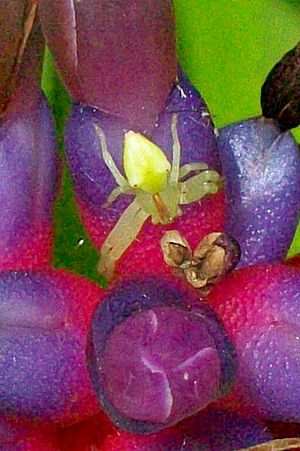Sidymella rubrosignata facts for kids
Quick facts for kids Sidymella rubrosignata |
|
|---|---|
 |
|
| Sidymella rubrosignata juvenile on a bromeliad at Chatswood West, Australia | |
| Scientific classification | |
| Synonyms | |
|
The Sidymella rubrosignata is a type of crab spider. You can find it in Australia. It's quite common, especially on plants called Dianella.
Unlike many spiders, Sidymella rubrosignata doesn't spin a web to catch food. Instead, it's a 'wait-and-pounce' hunter. It hides and waits for insects or other small spiders to come close. Then, it quickly grabs them!
Contents
What Does This Spider Look Like?
These spiders are often a clever green color. This helps them blend in perfectly with green leaves or flowers. It makes them very hard to spot! Sometimes, they can also be yellow, light brown, or even reddish.
Size Differences
Male Sidymella rubrosignata spiders are about 4.5 millimeters (0.18 inches) long. Females are larger, growing to about 8 millimeters (0.31 inches). Males are also thinner than females.
Body Features
The two front pairs of legs on this spider are much longer than the back two pairs. Its body, called the cephalothorax, is shaped like a pear. The back part of its body, the abdomen, looks like a trapezoid. It has two small bumps on its back, each with a red patch.
Life Cycle and Reproduction
Sidymella rubrosignata spiders lay their eggs in a special egg sac.
The Egg Sac
The female spider creates her egg sac inside a leaf. She folds the tip of the leaf back to cover the eggs. Then, she curls the edges of the leaf around with silk. This protects the eggs inside.
The eggs themselves are about 0.8 millimeters (0.03 inches) wide. They are not sticky and have a creamy color. Usually, there are between 20 and 35 eggs in each egg sac.
How This Spider Got Its Name
This spider was first described in 1874 by a scientist named Ludwig Koch. He first put it in a group of spiders called Stephanopis.
Later, in 1917, another scientist moved it to a group called Sidyma. However, it was found that a group of moths already had that name! So, in 1942, a scientist named Strand gave the spider its current name, Sidymella.
See also
 In Spanish: Sidymella rubrosignata para niños
In Spanish: Sidymella rubrosignata para niños

